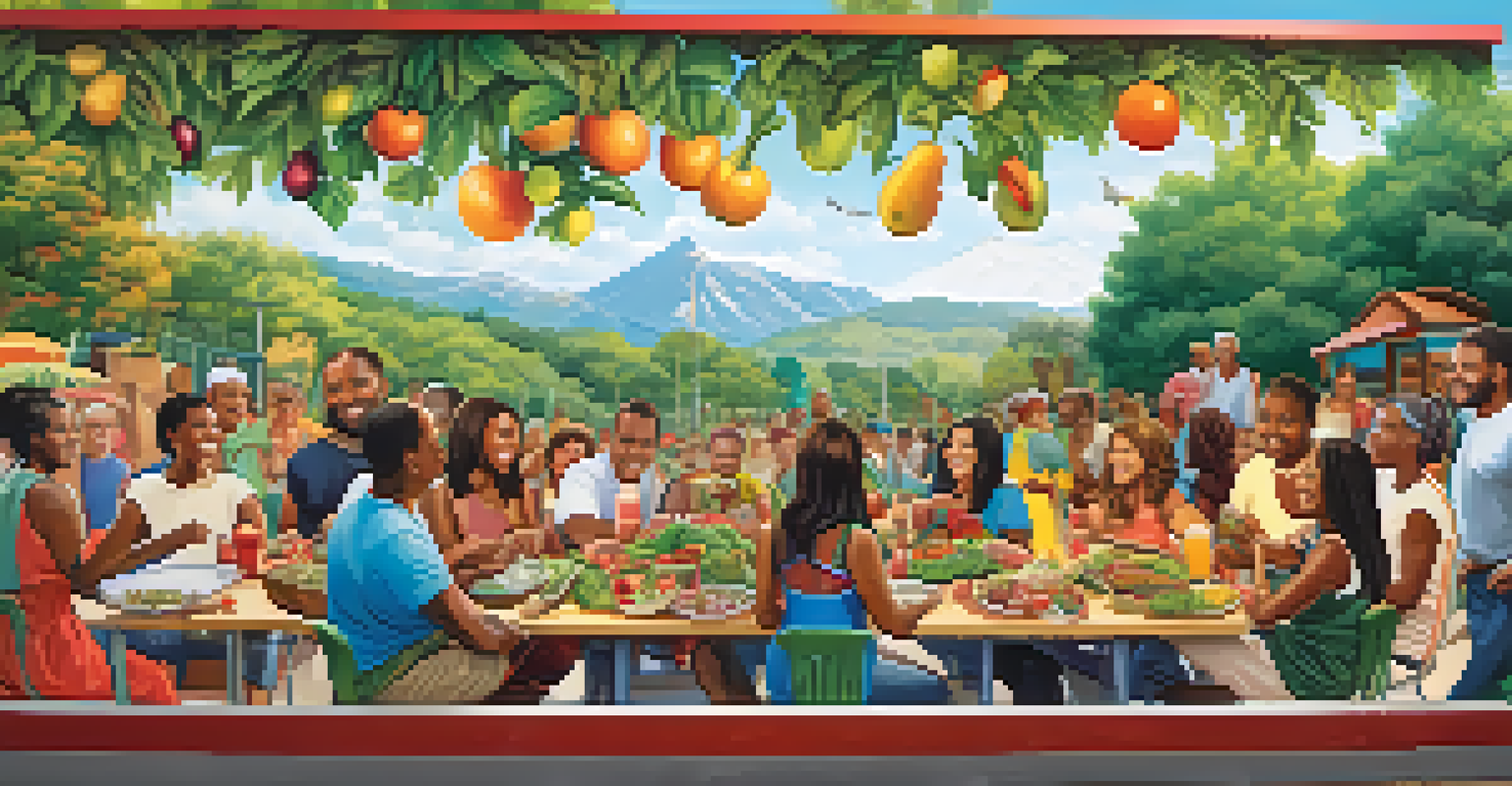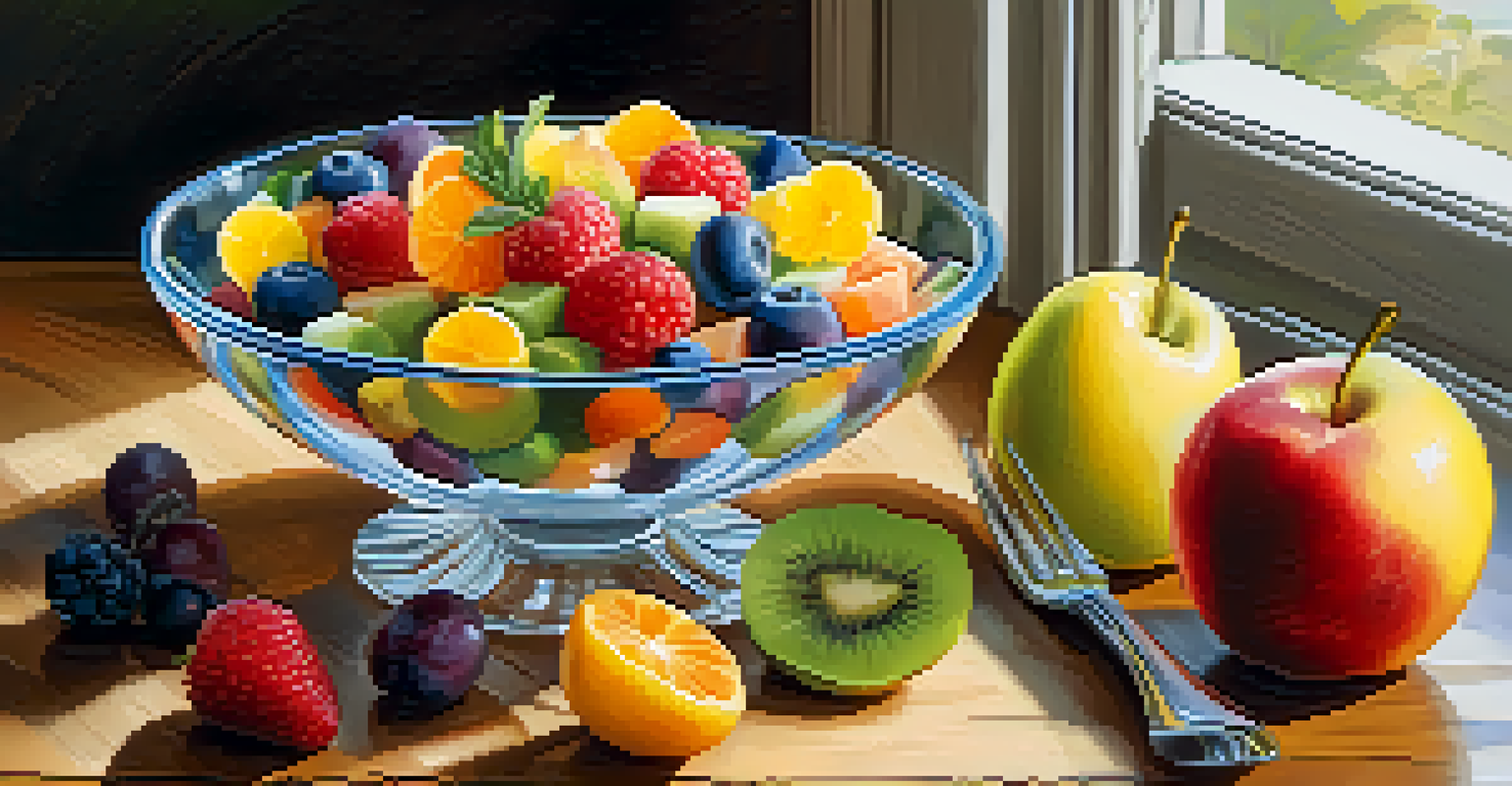Art and Nutrition: Visual Campaigns for Healthy Eating

The Power of Visuals in Promoting Healthy Eating
Visuals have a profound impact on our perception and behaviors, especially when it comes to food. Colorful images of fresh fruits and vegetables can evoke feelings of health and wellness, encouraging people to make better dietary choices. In fact, studies show that visually appealing food presentations can increase our appetite and desire for nutritious meals.
Food is not just what we eat; it’s a way of connecting with each other and the world around us.
When it comes to nutrition, visuals are not just about aesthetics; they serve as powerful tools for education. Infographics, for instance, can simplify complex nutritional information, making it more digestible for the average person. By using relatable visuals, we can demystify the benefits of healthy eating and inspire action.
Moreover, art can act as a bridge between diverse communities and cultures, showcasing various healthy dietary practices. Through engaging imagery, we can celebrate food traditions that promote wellness while fostering a sense of belonging and community.
Art as a Medium for Nutrition Education
Art has always been an integral part of education, and nutrition is no exception. By incorporating artistic elements into nutrition education, we can create more engaging and memorable experiences for learners of all ages. For example, interactive murals or community art projects can provide a hands-on approach to understanding healthy eating habits.

Workshops that blend art and nutrition can be particularly effective in reaching children and adolescents. When kids create their own food art, they not only learn about the food pyramid but also develop a personal connection to healthy eating. This hands-on approach makes the learning process enjoyable and impactful.
Visuals Enhance Healthy Eating Choices
Colorful images and artistic presentations of food can inspire better dietary choices and increase our desire for nutritious meals.
Additionally, art can help convey important messages about food sustainability and local sourcing. By visually representing these concepts, we can inspire individuals to make conscious choices about the food they consume and its impact on the environment.
Successful Campaigns Using Art to Promote Nutrition
Many successful campaigns have harnessed the power of art to promote healthy eating. One notable example is the 'Food is Art' initiative, which showcases local chefs and artists collaborating to create visually stunning dishes. This campaign not only highlights the beauty of nutritious food but also encourages local dining and community support.
Art is the most beautiful of all lies; it is the bridge connecting our emotions to our choices.
Another inspiring campaign is the 'Eat Well, Live Well' project, which utilizes vibrant murals in urban areas to inspire healthier eating habits. These murals often depict local produce and emphasize the benefits of including more fruits and vegetables in daily meals. As a result, they create a visually appealing environment that fosters healthier lifestyle choices.
These campaigns demonstrate that art can effectively communicate important health messages, making nutrition accessible and appealing to a wider audience. By creatively engaging the community, they encourage a culture of health that resonates with people on a personal level.
The Role of Community Engagement in Art and Nutrition
Community engagement is essential when it comes to effective art and nutrition campaigns. Involving local artists, chefs, and community members fosters a sense of ownership and pride in the initiative. This collaborative approach not only amplifies the message but also ensures that it resonates with the target audience.
When communities come together to create art, they often share their own stories and cultural backgrounds, enriching the project with diverse perspectives. This inclusivity can lead to a deeper understanding of nutrition and health, as individuals learn from one another’s experiences and traditions. The result is a more tailored and relevant message that encourages healthier eating habits.
Art Engages Communities in Nutrition
Collaborative art projects foster community involvement, enriching nutrition education through shared cultural stories and experiences.
Furthermore, community-driven initiatives can help sustain interest in healthy eating over time. By continuously involving local participants, these projects can evolve, adapting to changes in community needs and preferences while keeping the conversation around nutrition alive.
Integrating Technology with Art for Nutritional Awareness
In this digital age, technology can enhance the impact of art in promoting nutrition. Social media platforms, for instance, allow artists and nutrition advocates to share their work with a global audience. By using engaging visuals and storytelling, they can spark conversations about healthy eating in ways that resonate with younger generations.
Augmented reality (AR) is another exciting avenue for merging art and nutrition. Imagine using your smartphone to see a virtual garden sprouting in your kitchen, showcasing the benefits of growing your own vegetables. This type of interactive experience can captivate users and inspire them to make healthier food choices in their own lives.
As technology continues to evolve, the possibilities for creative campaigns are endless. By leveraging digital tools, we can reach wider audiences, foster engagement, and ultimately promote a culture of health and nutrition that is both relatable and inspiring.
The Impact of Art on Food Choices and Dietary Habits
Art can significantly influence our food choices and dietary habits, often in subtle yet powerful ways. For example, restaurants that invest in attractive food plating and decor can enhance the dining experience, making patrons more likely to choose healthier options. This emphasis on presentation encourages a mindset that prioritizes nutritious meals.
Research shows that people are more inclined to try new foods when they are presented artistically. A colorful fruit salad arranged like a rainbow can entice someone who typically avoids fruits, transforming their attitude toward healthy eating. This simple shift in presentation can lead to lasting changes in dietary habits.
Technology Amplifies Nutrition Awareness
Integrating technology with art, such as social media and augmented reality, can create engaging campaigns that promote healthy eating among diverse audiences.
Moreover, art can evoke emotional responses that can guide our food choices. When we see artwork depicting the joys of shared meals and wholesome ingredients, we are reminded of the importance of nutrition in our lives, which can motivate us to prioritize healthy eating in our daily routines.
Future Trends: Art and Nutrition in a Changing World
As we look toward the future, the integration of art and nutrition will likely continue to evolve in response to societal changes. With growing awareness around issues like food insecurity and climate change, artistic campaigns will need to address these topics while promoting healthy eating. This will involve creative storytelling that connects food choices with broader social and environmental impacts.
Additionally, there is a rising trend of incorporating cultural art forms into nutrition education. By celebrating diverse culinary traditions through visual art, we can create more inclusive narratives around healthy eating that resonate with different communities. This approach fosters a sense of belonging and encourages individuals to embrace their cultural heritage while making healthier choices.

Ultimately, the future of art and nutrition lies in collaboration and innovation. By embracing new technologies and art forms, we can continue to inspire and educate individuals about the importance of healthy eating in a way that is engaging, memorable, and impactful.